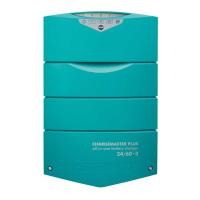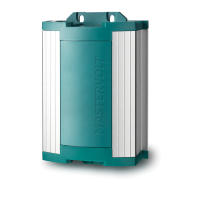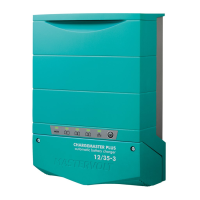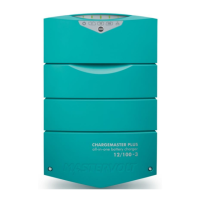12/75-3, 12/100-3, 24/40-3, 24/60-3 – User and Installation Manual
cable must be fused and connected to the positive post of
the battery bank.
The recommended DC fuses for outputs 1, 2 and 3 are:
The fuse with the fuse-holder is available from your local
Mastervolt distributor or Customer Service Representative.
3.3.2 AC wiring
WARNING!
On first connecting to power, make sure the
ChargeMaster Plus is in a well-ventilated area
as it might spark.
The ground wire offers protection only if the
enclosure of the ChargeMaster Plus is
connected to the safety ground. Connect the
ground terminal (PE / GND) to the hull or the
CAUTION!
According to local regulations an RCD/Breaker
(also known as GFCI) must be placed in the
AC input circuit of the ChargeMaster Plus.
For Australia and New Zealand, the wiring
rules are in accordance with AS/NZS 3000.
For a safe installation the correct wire cross section must
be applied. Don’t use a cross section that is smaller than
indicated. See the following table to select the appropriate
cross section for the AC wiring (up to 6m / 20ft length):
AC Current
Connection of AC wiring and recommended wire colors:
• 230V/50Hz installations:
• 120V/60Hz installations (single phase):
• 240V/60Hz installations (split phase 120/240VAC):
3.4 Batteries
Always follow the instructions published by the battery
manufacturer.
Recommended battery capacity
Minimum based on Mastervolt GEL batteries.
3.5 Things you need
Make sure you have all the parts you need to install the
ChargeMaster Plus:
• ChargeMaster Plus (included).
• Battery temperature sensor with cable and plug
(included).
• DC cables to connect the ChargeMaster Plus to the
batteries and common negative; see section 3.3.1 for
specifications.
• DC fuse holder with a DC fuse, to be integrated in the
positive DC cable; see section 3.3.1 for specifications.
• Screws / bolts (Ø 6mm with plugs) to mount the
enclosure to a surface. Use mounting materials which
are suitable to carry the weight of the ChargeMaster
Plus.
• AC cable to connect the AC input to an AC power
source. See section 3.3.2.
• Batteries. See section 3.4.
• Appropriate and reliable cable terminals, cable lugs,
battery terminals and cord end terminals.
We recommend as a minimum tool kit:
• Socket wrench 13mm to fix the main DC cables.
• Socket wrench 10mm to fix the Safety ground
connection.
• Flat blade screw driver 1.0 × 4.0mm to fix the screw
terminals of the AC wiring.
• Tools to fix the screws / bolts (Ø 6mm) with plugs to
mount the enclosure to a surface.
• Philips screw driver number 2 to open the connection
compartment.

